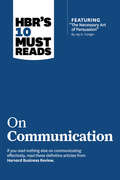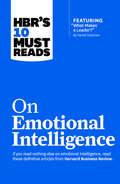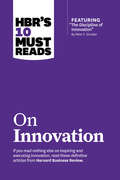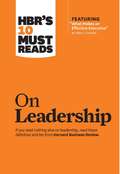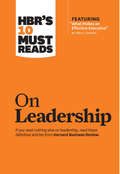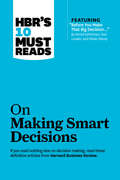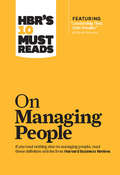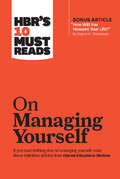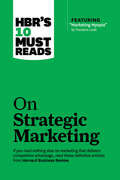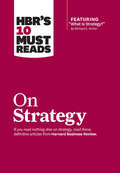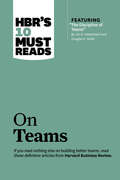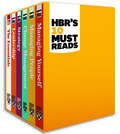- Table View
- List View
HBR's 10 Must Reads on Communication (with featured article The Necessary Art of Persuasion, by Jay A. Conger)
by Harvard Business ReviewNEW from the bestselling HBR's 10 Must Reads series.The best leaders know how to communicate clearly and persuasively. How do you stack up?If you read nothing else on communicating effectively, read these 10 articles. We've combed through hundreds of articles in the Harvard Business Review archive and selected the most important ones to help you express your ideas with clarity and impact-no matter what the situation.Leading experts such as Deborah Tannen, Jay Conger, and Nick Morgan provide the insights and advice you need to: Pitch your brilliant idea-successfully Connect with your audience Establish credibility Inspire others to carry out your vision Adapt to stakeholders' decision-making styles Frame goals around common interests Build consensus and win supportLooking for more Must Read articles from Harvard Business Review? Check out these titles in the popular series:HBR's 10 Must Reads: The EssentialsHBR's 10 Must Reads on CollaborationHBR's 10 Must Reads on InnovationHBR's 10 Must Reads on LeadershipHBR's 10 Must Reads on Making Smart DecisionsHBR's 10 Must Reads on Managing YourselfHBR's 10 Must Reads on Strategic MarketingHBR's 10 Must Reads on Teams
HBR's 10 Must Reads on Communication (with featured article The Necessary Art of Persuasion, by Jay A. Conger)
by Harvard Business ReviewNEW from the bestselling HBR's 10 Must Reads series.The best leaders know how to communicate clearly and persuasively. How do you stack up?If you read nothing else on communicating effectively, read these 10 articles. We've combed through hundreds of articles in the Harvard Business Review archive and selected the most important ones to help you express your ideas with clarity and impact-no matter what the situation.Leading experts such as Deborah Tannen, Jay Conger, and Nick Morgan provide the insights and advice you need to: Pitch your brilliant idea-successfully Connect with your audience Establish credibility Inspire others to carry out your vision Adapt to stakeholders' decision-making styles Frame goals around common interests Build consensus and win supportLooking for more Must Read articles from Harvard Business Review? Check out these titles in the popular series:HBR's 10 Must Reads: The EssentialsHBR's 10 Must Reads on CollaborationHBR's 10 Must Reads on InnovationHBR's 10 Must Reads on LeadershipHBR's 10 Must Reads on Making Smart DecisionsHBR's 10 Must Reads on Managing YourselfHBR's 10 Must Reads on Strategic MarketingHBR's 10 Must Reads on Teams
HBR's 10 Must Reads on Communication (with featured article The Necessary Art of Persuasion, by Jay A. Conger)
by Harvard Business ReviewNEW from the bestselling HBR's 10 Must Reads series.The best leaders know how to communicate clearly and persuasively. How do you stack up?If you read nothing else on communicating effectively, read these 10 articles. We've combed through hundreds of articles in the Harvard Business Review archive and selected the most important ones to help you express your ideas with clarity and impact-no matter what the situation.Leading experts such as Deborah Tannen, Jay Conger, and Nick Morgan provide the insights and advice you need to: Pitch your brilliant idea-successfully Connect with your audience Establish credibility Inspire others to carry out your vision Adapt to stakeholders' decision-making styles Frame goals around common interests Build consensus and win supportLooking for more Must Read articles from Harvard Business Review? Check out these titles in the popular series:HBR's 10 Must Reads: The EssentialsHBR's 10 Must Reads on CollaborationHBR's 10 Must Reads on InnovationHBR's 10 Must Reads on LeadershipHBR's 10 Must Reads on Making Smart DecisionsHBR's 10 Must Reads on Managing YourselfHBR's 10 Must Reads on Strategic MarketingHBR's 10 Must Reads on Teams
HBR's 10 Must Reads on Communication (with featured article The Necessary Art of Persuasion, by Jay A. Conger)
by Harvard Business ReviewNEW from the bestselling HBR's 10 Must Reads series.The best leaders know how to communicate clearly and persuasively. How do you stack up?If you read nothing else on communicating effectively, read these 10 articles. We've combed through hundreds of articles in the Harvard Business Review archive and selected the most important ones to help you express your ideas with clarity and impact-no matter what the situation.Leading experts such as Deborah Tannen, Jay Conger, and Nick Morgan provide the insights and advice you need to: Pitch your brilliant idea-successfully Connect with your audience Establish credibility Inspire others to carry out your vision Adapt to stakeholders' decision-making styles Frame goals around common interests Build consensus and win supportLooking for more Must Read articles from Harvard Business Review? Check out these titles in the popular series:HBR's 10 Must Reads: The EssentialsHBR's 10 Must Reads on CollaborationHBR's 10 Must Reads on InnovationHBR's 10 Must Reads on LeadershipHBR's 10 Must Reads on Making Smart DecisionsHBR's 10 Must Reads on Managing YourselfHBR's 10 Must Reads on Strategic MarketingHBR's 10 Must Reads on Teams
HBR's 10 Must Reads on Emotional Intelligence (with featured article "What Makes a Leader?" by Daniel Goleman)
by Harvard Business ReviewIn his defining work on emotional intelligence, bestselling author Daniel Goleman found that it is twice as important as other competencies in determining outstanding leadership.If you read nothing else on emotional intelligence, read these 10 articles by experts in the field. We've combed through hundreds of articles in the Harvard Business Review archive and selected the most important ones to help you boost your emotional skills-and your professional success.This book will inspire you to: Monitor and channel your moods and emotions Make smart, empathetic people decisions Manage conflict and regulate emotions within your team React to tough situations with resilience Better understand your strengths, weaknesses, needs, values, and goals Develop emotional agility
HBR's 10 Must Reads on Innovation (with featured article The Discipline of Innovation, by Peter F. Drucker)
by Harvard Business ReviewNEW from the bestselling HBR's 10 Must Reads series.To innovate profitably, you need more than just creativity. Do you have what it takes?If you read nothing else on inspiring and executing innovation, read these 10 articles. We've combed through hundreds of articles in the Harvard Business Review archive and selected the most important ones to help you innovate effectively.Leading experts such as Clayton Christensen, Peter Drucker, and Rosabeth Moss Kanter provide the insights and advice you need to: Decide which ideas are worth pursuing Innovate through the front lines-not just from the top Adapt innovations from the developing world to wealthier markets Tweak new ventures along the way using discovery-driven planning Tailor your efforts to meet customers' most pressing needs Avoid classic pitfalls such as stifling innovation with rigid processesLooking for more Must Read articles from Harvard Business Review? Check out these titles in the popular series:HBR's 10 Must Reads: The EssentialsHBR's 10 Must Reads on CommunicationHBR's 10 Must Reads on CollaborationHBR's 10 Must Reads on LeadershipHBR's 10 Must Reads on Making Smart DecisionsHBR's 10 Must Reads on Managing YourselfHBR's 10 Must Reads on Strategic MarketingHBR's 10 Must Reads on Teams
HBR's 10 Must Reads on Innovation (with featured article The Discipline of Innovation, by Peter F. Drucker)
by Harvard Business ReviewNEW from the bestselling HBR's 10 Must Reads series.To innovate profitably, you need more than just creativity. Do you have what it takes?If you read nothing else on inspiring and executing innovation, read these 10 articles. We've combed through hundreds of articles in the Harvard Business Review archive and selected the most important ones to help you innovate effectively.Leading experts such as Clayton Christensen, Peter Drucker, and Rosabeth Moss Kanter provide the insights and advice you need to: Decide which ideas are worth pursuing Innovate through the front lines-not just from the top Adapt innovations from the developing world to wealthier markets Tweak new ventures along the way using discovery-driven planning Tailor your efforts to meet customers' most pressing needs Avoid classic pitfalls such as stifling innovation with rigid processesLooking for more Must Read articles from Harvard Business Review? Check out these titles in the popular series:HBR's 10 Must Reads: The EssentialsHBR's 10 Must Reads on CommunicationHBR's 10 Must Reads on CollaborationHBR's 10 Must Reads on LeadershipHBR's 10 Must Reads on Making Smart DecisionsHBR's 10 Must Reads on Managing YourselfHBR's 10 Must Reads on Strategic MarketingHBR's 10 Must Reads on Teams
HBR's 10 Must Reads on Innovation (with featured article The Discipline of Innovation, by Peter F. Drucker)
by Harvard Business ReviewNEW from the bestselling HBR's 10 Must Reads series.To innovate profitably, you need more than just creativity. Do you have what it takes?If you read nothing else on inspiring and executing innovation, read these 10 articles. We've combed through hundreds of articles in the Harvard Business Review archive and selected the most important ones to help you innovate effectively.Leading experts such as Clayton Christensen, Peter Drucker, and Rosabeth Moss Kanter provide the insights and advice you need to: Decide which ideas are worth pursuing Innovate through the front lines-not just from the top Adapt innovations from the developing world to wealthier markets Tweak new ventures along the way using discovery-driven planning Tailor your efforts to meet customers' most pressing needs Avoid classic pitfalls such as stifling innovation with rigid processesLooking for more Must Read articles from Harvard Business Review? Check out these titles in the popular series:HBR's 10 Must Reads: The EssentialsHBR's 10 Must Reads on CommunicationHBR's 10 Must Reads on CollaborationHBR's 10 Must Reads on LeadershipHBR's 10 Must Reads on Making Smart DecisionsHBR's 10 Must Reads on Managing YourselfHBR's 10 Must Reads on Strategic MarketingHBR's 10 Must Reads on Teams
HBR's 10 Must Reads on Innovation (with featured article The Discipline of Innovation, by Peter F. Drucker)
by Harvard Business ReviewNEW from the bestselling HBR's 10 Must Reads series.To innovate profitably, you need more than just creativity. Do you have what it takes?If you read nothing else on inspiring and executing innovation, read these 10 articles. We've combed through hundreds of articles in the Harvard Business Review archive and selected the most important ones to help you innovate effectively.Leading experts such as Clayton Christensen, Peter Drucker, and Rosabeth Moss Kanter provide the insights and advice you need to: Decide which ideas are worth pursuing Innovate through the front lines-not just from the top Adapt innovations from the developing world to wealthier markets Tweak new ventures along the way using discovery-driven planning Tailor your efforts to meet customers' most pressing needs Avoid classic pitfalls such as stifling innovation with rigid processesLooking for more Must Read articles from Harvard Business Review? Check out these titles in the popular series:HBR's 10 Must Reads: The EssentialsHBR's 10 Must Reads on CommunicationHBR's 10 Must Reads on CollaborationHBR's 10 Must Reads on LeadershipHBR's 10 Must Reads on Making Smart DecisionsHBR's 10 Must Reads on Managing YourselfHBR's 10 Must Reads on Strategic MarketingHBR's 10 Must Reads on Teams
HBR's 10 Must Reads on Leadership
by Harvard Business ReviewThis text offers managers and professionals the fundamental information they need to stay competitive in a fast-moving world.
HBR's 10 Must Reads on Leadership (with featured article What Makes an Effective Executive, by Peter F. Drucker)
by Harvard Business ReviewGo from being a good manager to an extraordinary leader.If you read nothing else on leadership, read these 10 articles (featuring "What Makes an Effective Executive," by Peter F. Drucker). We've combed through hundreds of Harvard Business Review articles on leadership and selected the most important ones to help you maximize your own and your organization's performance.HBR's 10 Must Reads On Leadership will inspire you to:- Motivate others to excel- Build your team's self-confidence in others- Provoke positive change- Set direction- Encourage smart risk-taking- Manage with tough empathy- Credit others for your success- Increase self-awareness- Draw strength from adversityThis collection of best-selling articles includes: featured article "What Makes an Effective Executive" by Peter F. Drucker, "What Makes a Leader?" "What Leaders Really Do," "The Work of Leadership," "Why Should Anyone Be Led by You?" "Crucibles of Leadership," "Level 5 Leadership: The Triumph of Humility and Fierce Resolve," "Seven Transformations of Leadership," "Discovering Your Authentic Leadership," and "In Praise of the Incomplete Leader."
HBR's 10 Must Reads on Making Smart Decisions (with featured article Before You Make That Big Decision by Daniel Kahneman, Dan Lovallo, and Olivier Sibony)
by Harvard Business ReviewNEW from the bestselling HBR's 10 Must Reads series.Learn why bad decisions happen to good managers-and how to make better ones.If you read nothing else on decision making, read these 10 articles. We've combed through hundreds of articles in the Harvard Business Review archive and selected the most important ones to help you and your organization make better choices and avoid common traps.Leading experts such as Ram Charan, Michael Mankins, and Thomas Davenport provide the insights and advice you need to: Make bold decisions that challenge the status quo Support your decisions with diverse data Evaluate risks and benefits with equal rigor Check for faulty cause-and-effect reasoning Test your decisions with experiments Foster and address constructive criticism Defeat indecisiveness with clear accountabilityLooking for more Must Read articles from Harvard Business Review? Check out these titles in the popular series:HBR's 10 Must Reads: The EssentialsHBR's 10 Must Reads on CommunicationHBR's 10 Must Reads on CollaborationHBR's 10 Must Reads on InnovationHBR's 10 Must Reads on LeadershipHBR's 10 Must Reads on Managing YourselfHBR's 10 Must Reads on Strategic MarketingHBR's 10 Must Reads on Teams
HBR's 10 Must Reads on Making Smart Decisions (with featured article Before You Make That Big Decision by Daniel Kahneman, Dan Lovallo, and Olivier Sibony)
by Harvard Business ReviewNEW from the bestselling HBR's 10 Must Reads series.Learn why bad decisions happen to good managers-and how to make better ones.If you read nothing else on decision making, read these 10 articles. We've combed through hundreds of articles in the Harvard Business Review archive and selected the most important ones to help you and your organization make better choices and avoid common traps.Leading experts such as Ram Charan, Michael Mankins, and Thomas Davenport provide the insights and advice you need to: Make bold decisions that challenge the status quo Support your decisions with diverse data Evaluate risks and benefits with equal rigor Check for faulty cause-and-effect reasoning Test your decisions with experiments Foster and address constructive criticism Defeat indecisiveness with clear accountabilityLooking for more Must Read articles from Harvard Business Review? Check out these titles in the popular series:HBR's 10 Must Reads: The EssentialsHBR's 10 Must Reads on CommunicationHBR's 10 Must Reads on CollaborationHBR's 10 Must Reads on InnovationHBR's 10 Must Reads on LeadershipHBR's 10 Must Reads on Managing YourselfHBR's 10 Must Reads on Strategic MarketingHBR's 10 Must Reads on Teams
HBR's 10 Must Reads on Making Smart Decisions (with featured article Before You Make That Big Decision by Daniel Kahneman, Dan Lovallo, and Olivier Sibony)
by Harvard Business ReviewNEW from the bestselling HBR's 10 Must Reads series.Learn why bad decisions happen to good managers-and how to make better ones.If you read nothing else on decision making, read these 10 articles. We've combed through hundreds of articles in the Harvard Business Review archive and selected the most important ones to help you and your organization make better choices and avoid common traps.Leading experts such as Ram Charan, Michael Mankins, and Thomas Davenport provide the insights and advice you need to: Make bold decisions that challenge the status quo Support your decisions with diverse data Evaluate risks and benefits with equal rigor Check for faulty cause-and-effect reasoning Test your decisions with experiments Foster and address constructive criticism Defeat indecisiveness with clear accountabilityLooking for more Must Read articles from Harvard Business Review? Check out these titles in the popular series:HBR's 10 Must Reads: The EssentialsHBR's 10 Must Reads on CommunicationHBR's 10 Must Reads on CollaborationHBR's 10 Must Reads on InnovationHBR's 10 Must Reads on LeadershipHBR's 10 Must Reads on Managing YourselfHBR's 10 Must Reads on Strategic MarketingHBR's 10 Must Reads on Teams
HBR's 10 Must Reads on Managing People (with featured article Leadership That Gets Results, by Daniel Goleman)
by Harvard Business Review"HBR's 10 Must Reads paperback series is the definitive collection of books for new and experienced leaders alike. Leaders looking for the inspiration that big ideas provide, both to accelerate their own growth and that of their companies, should look no further.HBR's 10 Must Reads series focuses on the core topics that every ambitious manager needs to know: leadership, strategy, change, managing people, and managing yourself. Harvard Business Review has sorted through hundreds of articles and selected only the most essential reading on each topic. Each title includes timeless advice that will be relevant regardless of an ever-changing business environment.Classic ideas, enduring advice, the best thinkers: HBR's 10 Must Reads. Managing people is fraught with challenges--even if you're a seasoned manager. Here's how to handle them.If you read nothing else on managing people, read these 10 articles. We've combed through hundreds of Harvard Business Review articles and selected the most important ones to help you maximize your employees' performance.HBR's 10 Must Reads on Managing People will inspire you to: Tailor your management styles to fit your people Motivate with more responsibility, not more money Support first-time managers Build trust by soliciting input Teach smart people how to learn from failure Build high-performing teams Manage your boss"
HBR's 10 Must Reads on Managing Yourself (with bonus article "How Will You Measure Your Life?" by Clayton M. Christensen)
by Harvard Business ReviewThe path to your professional success starts with a critical look in the mirror.If you read nothing else on managing yourself, read these 10 articles (plus the bonus article "How Will You Measure Your Life?" by Clayton M. Christensen). We've combed through hundreds of Harvard Business Review articles to select the most important ones to help you maximize yourself.HBR's 10 Must Reads on Managing Yourself will inspire you to:Stay engaged throughout your 50+-year work lifeTap into your deepest valuesSolicit candid feedbackReplenish physical and mental energyBalance work, home, community, and selfSpread positive energy throughout your organizationRebound from tough timesDecrease distractibility and frenzyDelegate and develop employees' initiativeThis collection of best-selling articles includes: bonus article "How Will You Measure Your Life?" by Clayton M. Christensen, "Managing Oneself," "Management Time: Who's Got the Monkey?," "How Resilience Works," "Manage Your Energy, Not Your Time," "Overloadeded Circuits: Why Smart People Underperform," "Be a Better Leader, Have a Richer Life," "Reclaim Your Job," "Moments of Greatness: Entering the Fundamental State of Leadership," "What to Ask the Person in the Mirror," and "Primal Leadership: The Hidden Driver of Great Performance."
HBR's 10 Must Reads on Strategic Marketing (with featured article Marketing Myopia, by Theodore Levitt)
by Harvard Business ReviewNEW from the bestselling HBR's 10 Must Reads series.Stop pushing products-and start cultivating relationships with the right customers.If you read nothing else on marketing that delivers competitive advantage, read these 10 articles. We've combed through hundreds of articles in the Harvard Business Review archive and selected the most important ones to help you reinvent your marketing by putting it-and your customers-at the center of your business.Leading experts such as Ted Levitt and Clayton Christensen provide the insights and advice you need to: Figure out what business you're really in Create products that perform the jobs people need to get done Get a bird's-eye view of your brand's strengths and weaknesses Tap a market that's larger than China and India combined Deliver superior value to your B2B customers End the war between sales and marketingLooking for more Must Read articles from Harvard Business Review? Check out these titles in the popular series:HBR's 10 Must Reads: The EssentialsHBR's 10 Must Reads on CommunicationHBR's 10 Must Reads on CollaborationHBR's 10 Must Reads on InnovationHBR's 10 Must Reads on LeadershipHBR's 10 Must Reads on Making Smart DecisionsHBR's 10 Must Reads on Managing YourselfHBR's 10 Must Reads on Teams
HBR's 10 Must Reads on Strategic Marketing (with featured article Marketing Myopia, by Theodore Levitt)
by Harvard Business ReviewNEW from the bestselling HBR's 10 Must Reads series.Stop pushing products-and start cultivating relationships with the right customers.If you read nothing else on marketing that delivers competitive advantage, read these 10 articles. We've combed through hundreds of articles in the Harvard Business Review archive and selected the most important ones to help you reinvent your marketing by putting it-and your customers-at the center of your business.Leading experts such as Ted Levitt and Clayton Christensen provide the insights and advice you need to: Figure out what business you're really in Create products that perform the jobs people need to get done Get a bird's-eye view of your brand's strengths and weaknesses Tap a market that's larger than China and India combined Deliver superior value to your B2B customers End the war between sales and marketingLooking for more Must Read articles from Harvard Business Review? Check out these titles in the popular series:HBR's 10 Must Reads: The EssentialsHBR's 10 Must Reads on CommunicationHBR's 10 Must Reads on CollaborationHBR's 10 Must Reads on InnovationHBR's 10 Must Reads on LeadershipHBR's 10 Must Reads on Making Smart DecisionsHBR's 10 Must Reads on Managing YourselfHBR's 10 Must Reads on Teams
HBR's 10 Must Reads on Strategic Marketing (with featured article Marketing Myopia, by Theodore Levitt)
by Harvard Business ReviewNEW from the bestselling HBR's 10 Must Reads series.Stop pushing products-and start cultivating relationships with the right customers.If you read nothing else on marketing that delivers competitive advantage, read these 10 articles. We've combed through hundreds of articles in the Harvard Business Review archive and selected the most important ones to help you reinvent your marketing by putting it-and your customers-at the center of your business.Leading experts such as Ted Levitt and Clayton Christensen provide the insights and advice you need to: Figure out what business you're really in Create products that perform the jobs people need to get done Get a bird's-eye view of your brand's strengths and weaknesses Tap a market that's larger than China and India combined Deliver superior value to your B2B customers End the war between sales and marketingLooking for more Must Read articles from Harvard Business Review? Check out these titles in the popular series:HBR's 10 Must Reads: The EssentialsHBR's 10 Must Reads on CommunicationHBR's 10 Must Reads on CollaborationHBR's 10 Must Reads on InnovationHBR's 10 Must Reads on LeadershipHBR's 10 Must Reads on Making Smart DecisionsHBR's 10 Must Reads on Managing YourselfHBR's 10 Must Reads on Teams
HBR's 10 Must Reads on Strategy (including featured article What Is Strategy? by Michael E. Porter)
by Harvard Business Review"HBR's 10 Must Reads paperback series is the definitive collection of books for new and experienced leaders alike. Leaders looking for the inspiration that big ideas provide, both to accelerate their own growth and that of their companies, should look no further.HBR's 10 Must Reads series focuses on the core topics that every ambitious manager needs to know: leadership, strategy, change, managing people, and managing yourself. Harvard Business Review has sorted through hundreds of articles and selected only the most essential reading on each topic. Each title includes timeless advice that will be relevant regardless of an ever-changing business environment.Classic ideas, enduring advice, the best thinkers: HBR's 10 Must Reads. Is your company spending too much time on strategy development--with too little to show for it?If you read nothing else on strategy, read these 10 articles. We've combed through hundreds of Harvard Business Review articles and selected the most important ones to help you catalyze your organization's strategy development and execution.HBR's 10 Must Reads on Strategy will inspire you to: Distinguish your company from rivals Clarify what your company will and won't do Craft a vision for an uncertain future Create blue oceans of uncontested market space Use the Balanced Scorecard to measure your strategy Capture your strategy in a memorable phrase Make priorities explicit Allocate resources early Clarify decision rights for faster decision making"
HBR's 10 Must Reads on Teams (with featured article The Discipline of Teams, by Jon R. Katzenbach and Douglas K. Smith)
by Harvard Business ReviewNEW from the bestselling HBR's 10 Must Reads series.Most teams underperform. Yours can beat the odds.If you read nothing else on building better teams, read these 10 articles. We've combed through hundreds of articles in the Harvard Business Review archive and selected the most important ones to help you assemble and steer teams that get results.Leading experts such as Jon Katzenbach, Teresa Amabile, and Tamara Erickson provide the insights and advice you need to: Boost team performance through mutual accountability Motivate large, diverse groups to tackle complex projects Increase your teams' emotional intelligence Prevent decision deadlock Extract results from a bunch of touchy superstars Fight constructively with top-management colleaguesLooking for more Must Read articles from Harvard Business Review? Check out these titles in the popular series:HBR's 10 Must Reads: The EssentialsHBR's 10 Must Reads on CommunicationHBR's 10 Must Reads on CollaborationHBR's 10 Must Reads on InnovationHBR's 10 Must Reads on LeadershipHBR's 10 Must Reads on Making Smart DecisionsHBR's 10 Must Reads on Managing YourselfHBR's 10 Must Reads on Strategic Marketing
HBR's 10 Must Reads on Teams (with featured article The Discipline of Teams, by Jon R. Katzenbach and Douglas K. Smith)
by Harvard Business ReviewNEW from the bestselling HBR's 10 Must Reads series.Most teams underperform. Yours can beat the odds.If you read nothing else on building better teams, read these 10 articles. We've combed through hundreds of articles in the Harvard Business Review archive and selected the most important ones to help you assemble and steer teams that get results.Leading experts such as Jon Katzenbach, Teresa Amabile, and Tamara Erickson provide the insights and advice you need to: Boost team performance through mutual accountability Motivate large, diverse groups to tackle complex projects Increase your teams' emotional intelligence Prevent decision deadlock Extract results from a bunch of touchy superstars Fight constructively with top-management colleaguesLooking for more Must Read articles from Harvard Business Review? Check out these titles in the popular series:HBR's 10 Must Reads: The EssentialsHBR's 10 Must Reads on CommunicationHBR's 10 Must Reads on CollaborationHBR's 10 Must Reads on InnovationHBR's 10 Must Reads on LeadershipHBR's 10 Must Reads on Making Smart DecisionsHBR's 10 Must Reads on Managing YourselfHBR's 10 Must Reads on Strategic Marketing
HBR's 10 Must Reads on Teams (with featured article The Discipline of Teams, by Jon R. Katzenbach and Douglas K. Smith)
by Harvard Business ReviewNEW from the bestselling HBR's 10 Must Reads series.Most teams underperform. Yours can beat the odds.If you read nothing else on building better teams, read these 10 articles. We've combed through hundreds of articles in the Harvard Business Review archive and selected the most important ones to help you assemble and steer teams that get results.Leading experts such as Jon Katzenbach, Teresa Amabile, and Tamara Erickson provide the insights and advice you need to: Boost team performance through mutual accountability Motivate large, diverse groups to tackle complex projects Increase your teams' emotional intelligence Prevent decision deadlock Extract results from a bunch of touchy superstars Fight constructively with top-management colleaguesLooking for more Must Read articles from Harvard Business Review? Check out these titles in the popular series:HBR's 10 Must Reads: The EssentialsHBR's 10 Must Reads on CommunicationHBR's 10 Must Reads on CollaborationHBR's 10 Must Reads on InnovationHBR's 10 Must Reads on LeadershipHBR's 10 Must Reads on Making Smart DecisionsHBR's 10 Must Reads on Managing YourselfHBR's 10 Must Reads on Strategic Marketing
HBR's 20-Minute Manager Boxed Set
by Harvard Business ReviewAnthology containing: Presentations (20-Minute Manager Series) Creating Business Plans (20-Minute Manager Series) Giving Effective Feedback (20-Minute Manager Series) Delegating Work (20-Minute Manager Series) Finance Basics (20-Minute Manager Series) Getting Work Done (20-Minute Manager Series) Managing Time (20-Minute Manager Series) Running Meetings (20-Minute Manager Series) Managing Up (20-Minute Manager Series) Managing Projects (20-Minute Manager Series)
HBR's Must Reads Digital Boxed Set (6 Books)
by Harvard Business ReviewYou want the most important ideas on management all in one place. Now you can have them-in a boxed set of HBR's Must Reads.This six-title collection includes only the most critical articles from the world's top management experts, curated from Harvard Business Review's rich archives. We've done the work of selecting them so you won't have to. From leadership and strategy to managing yourself and others, HBR's Must Reads offer foundational articles on essential business topics to help you maximize your organization's performance and your own.The series includes:HBR's 10 Must Reads: The EssentialsThis book brings together the best thinking from management's most influential experts. Arm yourself with the insights of Michael Porter on competitive advantage, John Kotter on leading change, Daniel Goleman on emotional intelligence, Peter Drucker on managing your career, Clayton Christensen on disruptive innovation, Tom Davenport on analytics, Robert Kaplan and David Norton on measuring strategy with the "balanced scorecard," Rosabeth Moss Kanter on innovation, Ted Levitt on marketing, and C.K. Prahalad and Gary Hamel on core competence. Once you've read these definitive articles, you can delve into each core topic the series explores: managing yourself, managing people, leadership, strategy, and change management.HBR's 10 Must Reads on Managing YourselfThe path to your professional success starts with a critical look in the mirror. Here's how to stay engaged throughout your 50-year work life, tap into your deepest values, solicit candid feedback, replenish your physical and mental energy, and rebound from tough times. This book includes the bonus article "How Will You Measure Your Life?" by Clayton M. Christensen.HBR's 10 Must Reads on Managing PeopleManaging your employees is fraught with challenges, even if you're a seasoned pro. Boost their performance by tailoring your management styles to their temperaments, motivating with responsibility rather than money, fostering trust through solicited input, giving rookie managers the support they need, and building high-performing teams.HBR's 10 Must Reads on LeadershipAre you an extraordinary leader-or just a good manager? Learn how to motivate others to excel, build your team's confidence, set direction, encourage smart risk-taking, credit others for your success, and draw strength from adversity.HBR's 10 Must Reads on StrategyIs your company spending too much time on strategy development, with too little to show for it? Discover what it takes to distinguish your company from rivals, clarify what it will (and won't) do, create blue oceans of uncontested market space, and make your priorities explicit so employees can realize your vision.HBR's 10 Must Reads on Change ManagementMost companies' change initiatives fail-but yours can beat the odds. Learn how to overcome addiction to the status quo, establish a sense of urgency, mobilize commitment and resources, silence naysayers, minimize the pain of change, and motivate change even when business is good.
